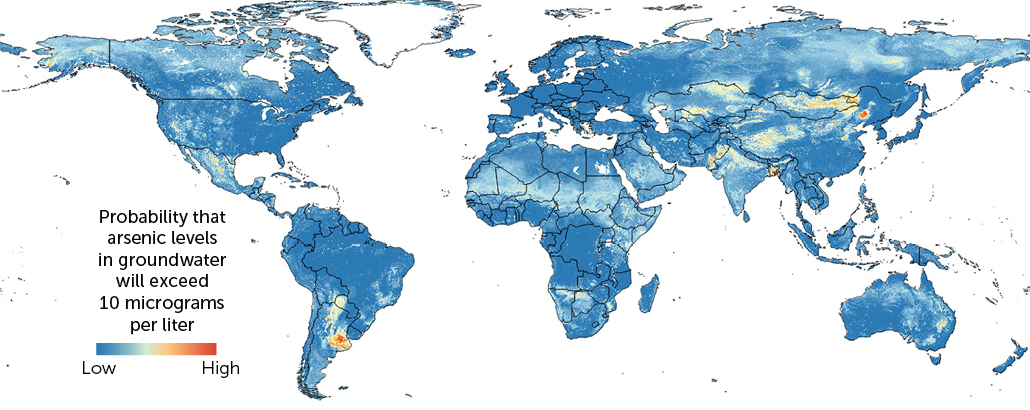Widespread Drinking Water Contamination In America: Millions At Risk

Table of Contents
Sources of Drinking Water Contamination in the US
The sources of drinking water contamination in the United States are multifaceted and complex. They range from aging infrastructure to industrial pollution and naturally occurring contaminants.
Aging Infrastructure
America's water infrastructure is aging rapidly. Decades of underinvestment have left many water systems struggling to deliver safe, clean water. This aging infrastructure is a major contributor to drinking water contamination.
- Leaking pipes: Old lead pipes, particularly common in older homes and cities, leach lead into the water supply, causing serious health problems.
- Insufficient filtration systems: Outdated water treatment plants often lack the capacity or technology to effectively remove modern contaminants.
- Lack of regular maintenance and updates: Insufficient funding and maintenance lead to deterioration, increasing the risk of leaks and contamination.
Data reveals a concerning picture: The American Society of Civil Engineers estimates that over $1 trillion is needed to upgrade the nation's aging water infrastructure. Cities like Flint, Michigan, serve as stark reminders of the devastating consequences of failing infrastructure, where lead contamination led to a public health crisis.
Industrial Pollution
Industrial discharge and agricultural runoff significantly contribute to drinking water contamination. These activities introduce a range of harmful chemicals into water sources.
- PFAS contamination: These "forever chemicals" used in manufacturing and firefighting foam are highly persistent and linked to various health issues. Many industrial sites have left behind a legacy of PFAS contamination.
- Pesticide and fertilizer runoff: Agricultural practices contribute to water pollution through the runoff of pesticides and fertilizers, contaminating rivers, lakes, and groundwater.
- Mining activities: Mining operations can release heavy metals and other toxins into water sources, leading to widespread contamination.
The Environmental Protection Agency (EPA) regularly publishes reports detailing industrial pollution and its impact on water quality. These reports are crucial for understanding the scope of this problem.
Natural Contaminants
Some contaminants occur naturally in the environment and can infiltrate water sources.
- Arsenic and radon: These naturally occurring substances can seep into groundwater, posing significant health risks. The geological composition of certain regions increases the likelihood of such contamination.
- Variations in contamination levels: The levels of naturally occurring contaminants vary greatly depending on geographical location and geological formations.
Areas with specific geological characteristics are particularly vulnerable to naturally occurring contaminants. Understanding the geology of your region is crucial in assessing your risk.
Health Risks Associated with Contaminated Drinking Water
The health risks associated with contaminated drinking water are severe and far-reaching. Exposure can lead to both short-term and long-term health consequences.
Short-Term Effects
Short-term effects of consuming contaminated water can include:
- Nausea
- Vomiting
- Diarrhea
- Skin rashes
The severity of these symptoms depends on the type and concentration of contaminants.
Long-Term Effects
Long-term exposure to contaminated drinking water is linked to several serious health problems:
- Cancer
- Developmental problems in children (lead poisoning)
- Reproductive issues
- Neurological damage
Studies have consistently demonstrated the link between long-term exposure to specific contaminants and increased risks of these diseases. The long-term consequences can be devastating, affecting individuals and communities for generations.
Protecting Yourself from Contaminated Drinking Water
Taking proactive steps is crucial to protect yourself and your family from contaminated drinking water.
Testing Your Water
Regular water testing is essential to identify potential contaminants.
- Find certified water testing labs in your area.
- Determine which contaminants to test for based on your location and potential sources of contamination.
- Learn how to interpret your test results.
Many resources are available online to help you find certified water testing services.
Water Filtration Systems
Investing in a home water filtration system can significantly reduce your exposure to contaminants.
- Consider different types of filters, such as carbon filters and reverse osmosis systems, and their effectiveness against specific contaminants.
- Compare costs and features of various systems to find the best fit for your needs.
Bottled Water Alternatives
Bottled water may seem like a solution, but it comes with drawbacks:
- Environmental impact of plastic waste.
- Cost.
- Potential for contamination in bottled water itself.
Consider reusable water bottles and exploring alternative, eco-friendly solutions.
Advocating for Clean Drinking Water
You can play a critical role in ensuring clean drinking water for all.
Contacting Elected Officials
Contact your local, state, and national representatives to advocate for improved water infrastructure and stricter regulations.
- Find contact information for your elected officials.
- Write effective emails or letters expressing your concerns.
- Participate in public forums and town hall meetings.
Supporting Water Quality Organizations
Support non-profit organizations working to improve water quality through donations or volunteering.
Staying Informed
Stay informed about water quality issues in your community and across the country.
- Follow news sources that report on water quality.
- Subscribe to newsletters from water quality organizations.
Conclusion: Taking Action Against Widespread Drinking Water Contamination
The problem of drinking water contamination in America is severe and demands immediate attention. We've explored various sources of contamination, their significant health consequences, and effective protective measures. Don't wait for the government to solve the problem of drinking water contamination; test your water today and take steps to ensure your family’s safety. By taking personal responsibility and advocating for change, we can work towards a future where clean, safe drinking water is a right, not a privilege, for all Americans. Learn more and find resources to test your water at [link to relevant resource 1], [link to relevant resource 2], and [link to relevant resource 3].

Featured Posts
-
 Padres Aim To Maintain Home Winning Streak Against Visiting Rockies
May 16, 2025
Padres Aim To Maintain Home Winning Streak Against Visiting Rockies
May 16, 2025 -
 The Two Max Muncys An Imagined Encounter
May 16, 2025
The Two Max Muncys An Imagined Encounter
May 16, 2025 -
 Paddy Pimbletts Ufc 314 Fight Will He Become Champion
May 16, 2025
Paddy Pimbletts Ufc 314 Fight Will He Become Champion
May 16, 2025 -
 Barcelonas Official Response To Javier Tebas And La Ligas Actions
May 16, 2025
Barcelonas Official Response To Javier Tebas And La Ligas Actions
May 16, 2025 -
 Kid Cudis Personal Items Sell For Staggering Sums At Auction
May 16, 2025
Kid Cudis Personal Items Sell For Staggering Sums At Auction
May 16, 2025
